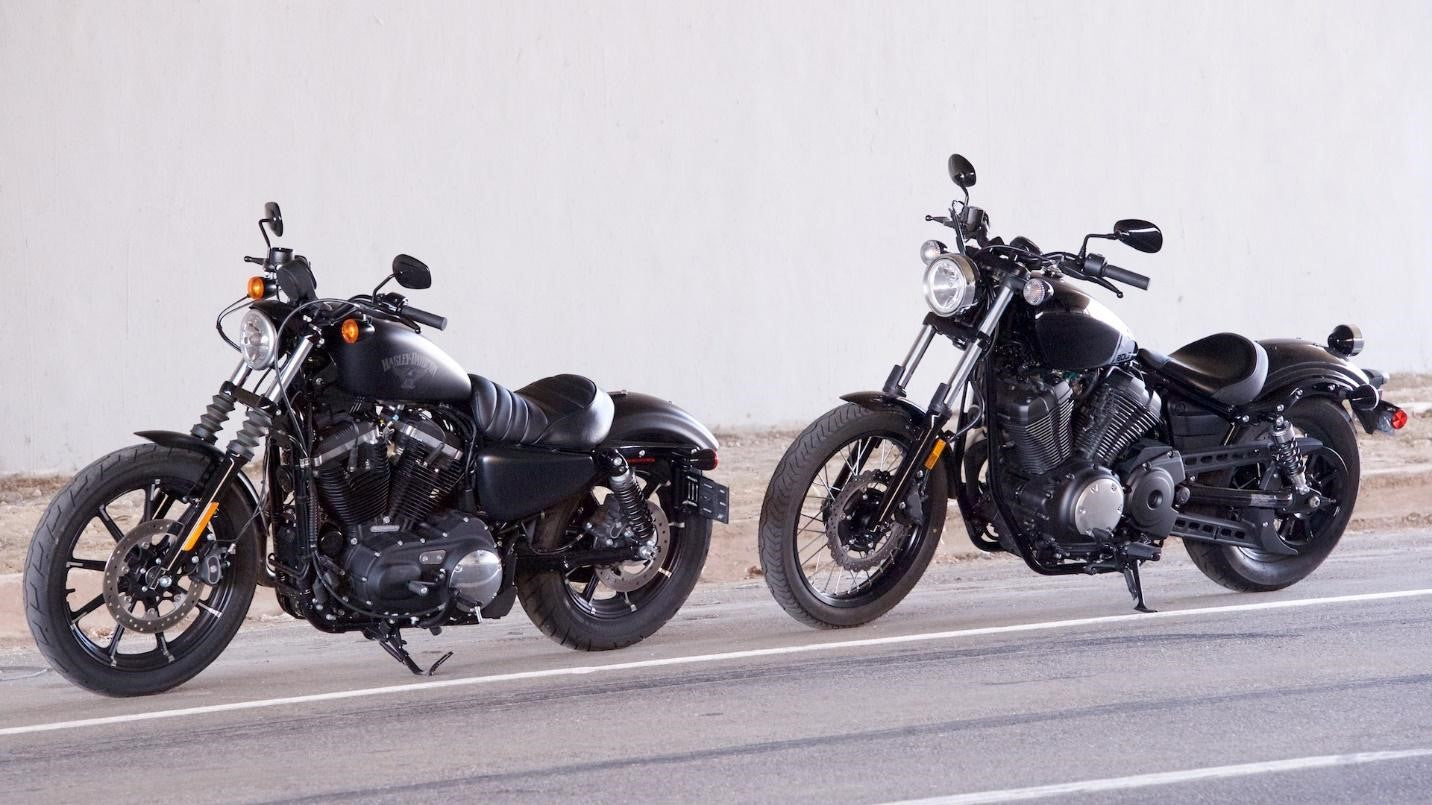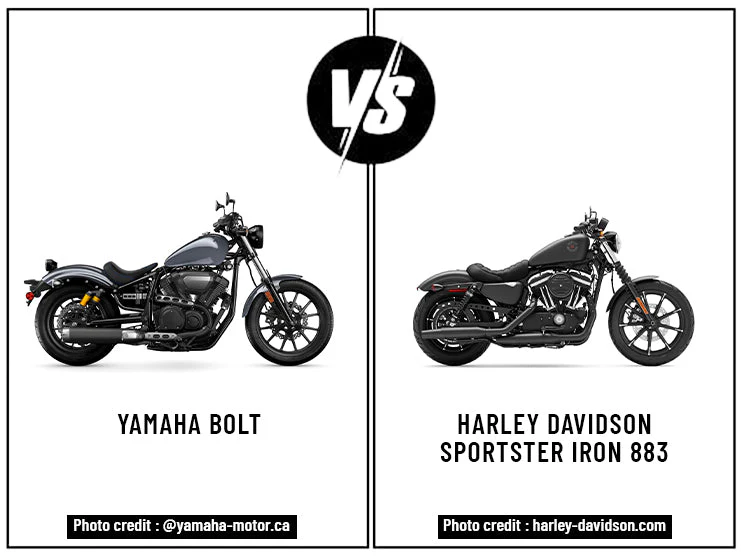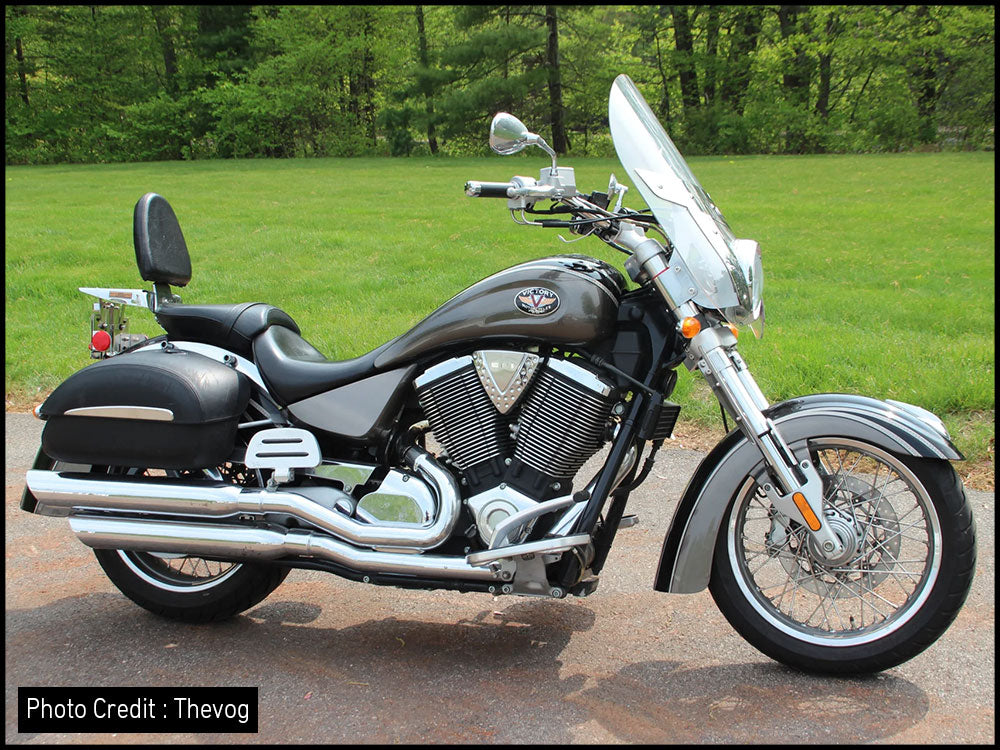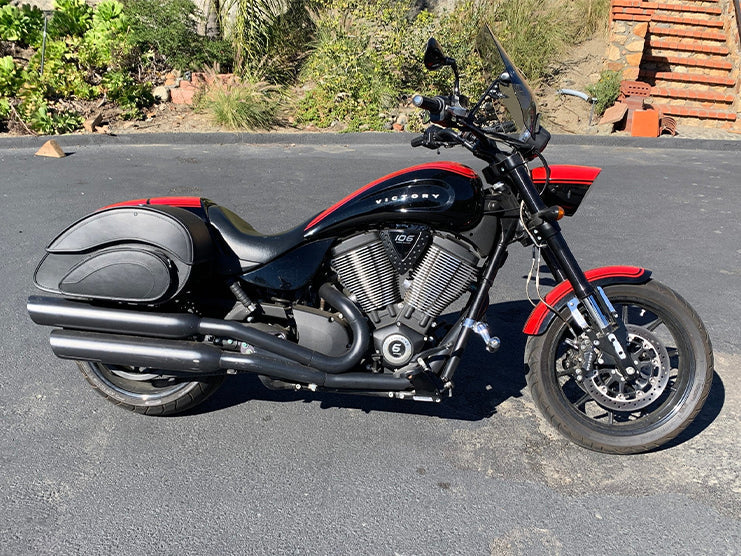Table of Content
1. YAMAHA BOLT AND HARLEY DAVIDSON IRON SPORSTER 883 AT FIRST GLANCE
The heart of any bike is its engine. This concept was the main principle behind the Harley Davidson’s Sportster lineup. Since it’s launch in 1957, the Sportster lineup served as hardcore entry level bikes and the Iron 883 was no exception. Powered with a 883cc Milwaukee engine, the Sportster Iron 883 was the only beginner’s bike in the market with a badass look and great performance until the release of the Yamaha Star Bolt in 2013.
Yamaha introduced the Star Bolt to the cruiser market as a direct competitor to the Harley-Davidson Iron 883. Powered by the 942cc Hamamatsu engine, the Yamaha Bolt had almost all the same features as the Iron 883. Both motorcycles were designed with a minimalistic look and had similar market prices: $7,990 for the Standard Yamaha Bolt and $7,999 for the Harley Sportster Iron 883.
Both bikes are considered cruiser models, but one is an American Iron while the other is a Japanese bike. Here’s a detailed comparison of both of these bikes, including the style, detailed specs and overall performance.
2. YAMAHA BOLT VS IRON SPORTSTER 883: DETAILED COMPARISON
2.1 STYLE
Both the Yamaha Bolt and Harley Davidson Iron 883 are urban cruisers featuring similar vintage style with bobbed rear fenders, low seating position, solo seat, belt drive, and almost complete absence of flashy chrome parts. While the Yamaha Bolt R-Spec came with a wide variety of color options (Matte Gray, Camo Green, etc.), blackened turn signals, and improved graphics, the Iron 883 had the better overall look with a more compact layout and good-quality Candy Orange paint job popping against the blacked-out background.
The Yamaha Bolt offers distinctive features such as the plastic extension on the back fender, peanut style gas tank, and limitless customization options. However, the Harley Iron 883 has a better overall fit and finish with some minor flaws which are easily offset by the precise attention to details. Both bikes can be customized with a wide range of accessories and are ideal for personal customization, but the Iron 883 has the advantage with the sheer amount of available aftermarket parts.
Pros
| Yamaha Bolt | H-D Iron Sportster 883 |
|---|---|
| Great out of the box styling | Superior fit and finish |
| Easy to ride | Easy to ride |
| Economical alternatives | Cool 13-spoke cast aluminium wheels |
Cons
| Yamaha Bolt | H-D Iron Sportster 883 |
|---|---|
| Unpleasant space between the tank and seat | Too much vibrations |
| Too dark color on Speedo | Poor brakes |
2.2 ENGINEERING
Manufacturing:
The only similarity between the Yamaha Bolt and Harley Davidson Iron Sportster 883 is that they both are powered by air-cooled V-twin engines. The Bolt has four valve heads and an overhead cam on top of each jug, but the Iron 883 has only two pushrod activated valves in each cylinder. While the Harley’s motor is typically undersquare, Yamaha uses a nearly square bore and stroke ratio.
Performance:
The Yamaha Bolt’s 942cc V-twin engine typically produces more horsepower than the Iron 883. When it comes to torque, the Bolt is capable of producing more torque throughout the rev range, in addition to having an anticipated overrev advantage. While the Iron Sportster 883 should produce more torque based on its arrangement, the long design of the stroke is overwhelmed by four valve heads and an extra 59 cubic centimeters.
Overall, the Yamaha Bolt has a greater cornering pull than the Harley Davidson Iron Sportster 883 and can provide a little bit more push when the stop light turns green. However, the torque curves for both the bikes are quite flat and devoid of any interesting surprises.
Starter:
In contrast to the Yamaha Bolt’s engine’s perfect mechanical operation, the Iron 883’s motor feels like a living thing when you turn it on. The growling sound of the engine is a sign that its battery is warming up correctly and quickly. On the contrary, the Yamaha Bolt’s engine has no drama and runs smoothly once the button is pressed.
Transmission:
Both bikes have well-spaced five speed transmission that provide smooth shifting between gears and effortless cruising down the highway at higher speeds.
Fuel Economy:
Although the Yamaha Bolt has a larger engine, it is somewhat more fuel efficient than the Iron Sportster 883, with the Bolt having a fuel economy of 21.2 kmpl as opposed to the Iron 883’s 20.8 kmpl fuel economy.
2.3 SUSPENSION, WHEELS AND BRAKES
The underpinnings on the Yamaha Bolt and Iron 883 are similar except for some minor differences. The Yamaha Bolt clearly outperforms the Iron 883 with its upgraded rear shock suspension, particularly with the R and C-Spec versions. Although the emulsion design in the Iron 883’s rear shock was also an improvement, the rear wheel travel remained at a meager 1.6 inches. Moreover, the forks are also thin and provide little stability on bumpy roads.
The Yamaha Bolt does a better job absorbing impacts from bumpy roads due to an extra inch of wheel travel on both sides. It is even more sophisticated in the Bolt R-Spec version which comes with adjustable piggyback shock absorbers and provides superior damping than the standard version.
Both the Yamaha Bolt and Iron 883 have the same set of tires, with the Bolt using Bridgestone exedra rubber and the Iron 83 using Michelin Scorcher 32 rubber. Both sets of high-profile tires considerably exceed any specifications established by the engine or chassis. The standard model of the Yamaha Bolt has traditional spoke wheels in contrast to the Iron 883’s conventional alloy wheels. While the tubed tires can be an obvious drawback, Yamaha also provides tubeless tires with alloy wheels on the R-Spec version which prioritizes functionality over originality.
The Yamaha Bolt has high tech wave rotors in the front and back that enable quicker braking. On the other hand, the Iron 883 has a wooden feel to the undersprung front end and the brakes feel slow in their response time, with a dead feeling at the lever. But unlike the Bolt, the rear brake in the Iron 883 is less likely to lock up when initiating a hard brake.
2.4 ERGONOMICS

Both the Yamaha Bolt and H-D Iron Sportster 883 have almost similar ergonomics. The pegs are located in the middle, the narrow bars are only slightly pulled back, and the seat is low and comfortable.
Although the Iron Sportster 883 is more compact than the Bolt, both bikes have enough space to fit on comfortably. The seat on the Yamaha Bolt is an inch lower, providing a better center of gravity compared to the Iron 883. The saddle on the Iron 883 is quite uncomfortable to sit on despite being made of a fine tuck and roll fabric. The grips are low and pegs are higher on the Iron Sportster 883 as compared to the Yamaha Bolt.
The Yamaha Bolt is preferable for extended road trips due to there being more space on the vehicle and a more comfortable seating position, although it has nearly the same tank capacity and range as the Iron 883.
2.5 RIDING EXPERIENCE
The Iron 883 is more maneuverable than the Yamaha Bolt, whether riding through mountain hills or cruising around town. The Iron 883 has more compact ergonomics and a short wheelbase despite being 20 lbs heavier than the Bolt.
However, the roles are reversed on urban highways. The more flexible suspension and longer wheelbase keeps the Bolt stable even at high speeds. The Bolt produces less vibrations even when travelling around the old highways with broken concrete.
2.6 PRICING
Both the Yamaha Bolt and Iron 883 have comparable prices: $7,999 for the Iron 883 and $7,990 for the Standard Bolt. But the Yamaha Bolt arguably provides its money’s worth due to its bigger engine. If you want a more traditional cruiser, the Yamaha Bolt is a good choice. However, if you want a classic Harley Davidson bike that can be completely customized, the Iron 883 is the bike for you.
3. YAMAHA BOLT VS IRON SPORTSTER 883: DETAILED SPECS
General Information
| Yamaha Bolt | H-D Iron Sportster 883 | |
|---|---|---|
| Manufacturer | Yamaha | Harley Davidson |
| Production | 2013-Present | 1986-Present |
| Model | Yamaha Bolt | Iron Sportster 883 |
| Category | Custom / Cruiser | Custom / Cruiser |
| Color | Matte Gray, Camo Green | Candy Orange |
| Price | $7,990 | $7,999 |
Dimension and Capacities
| Yamaha Bolt | H-D Iron Sportster 883 | |
|---|---|---|
| Wheelbase | 61.8 in | 59.02 in |
| Overall Length | 90.2 in | 87.2 in |
| Overall Width | 37.2 in | 33.31 in |
| Overall Height | 44.1 in | 43.9 in |
| Seat Height | 27.2 in | 26.8 in |
| Ground Clearance | 130mm | 140mm |
| Curb Weight | 252 kg | 256 kg |
| Fuel Capacity | 13 liters | 12.5 liters |
Transmission and Engine
| Yamaha Bolt | H-D Iron Sportster 883 | |
|---|---|---|
| Engine Type | 60° V-twin, four-stroke | 45° V-twin, four-stroke |
| Cooling | Air-cooled | Air-cooled |
| Displacement | 942 cc | 883cc |
| Bore and Stroke | 85 mm x 83 mm | 76.2mm x 96.8 mm |
| Compression Ratio | 9.0:1 | 9.0:1 |
| Valve Train | SOHC | Pushrod |
| Starting | Electric | Electric |
| Fuel System | Twin-bore electronic fuel injection, with throttle position sensor | Injection, Electronic Sequential Port Fuel Injection |
| Clutch | Multi-Wet Clutch | Multi-Plate |
| Final Drive | Belt | Belt |
| Transmission | Five-Speed | Five-Speed |
| Exhaust | Two-into-one exhaust pipe | Black exhaust headers and black mufflers |
Performance
| Yamaha Bolt | H-D Iron Sportster 883 | |
|---|---|---|
| Maximum Power | 65 hp at 5500 rpm | 51 hp at 600 rpm |
| Maximum Torque | 77 Nm at 3000 rpm | 70 Nm at 3500 rpm |
| Top Speed | 106 mph | 93 mph |
| Fuel Economy/Consumption | 51.02 mpg | 51 mpg |
Suspension, Chassis, Wheels and Brakes
| Yamaha Bolt | H-D Iron Sportster 883 | |
|---|---|---|
| Frame Type | Double cradle | Double cradle |
| Rear Suspension | Twin shock absorbers, Dual piggyback shock absorbers with adjustable preload in R-Spec variant | Twin shock absorbers |
| Front Suspension | Telescopic fork | Telescopic fork |
| Rear Brake | 298mm Petal disc | Disc with ABS |
| Front Brake | 298mm Petal disc | Disc with ABS |
| Rear Tire | 150/80 – 16 (Tubed / tubeless in R version) | 150/80 – 16 |
| Front Tire | 100/90 – 19 (Tubed / tubeless in R version) | 100/90 – 19 |













Leave a comment
All comments are moderated before being published.
This site is protected by hCaptcha and the hCaptcha Privacy Policy and Terms of Service apply.